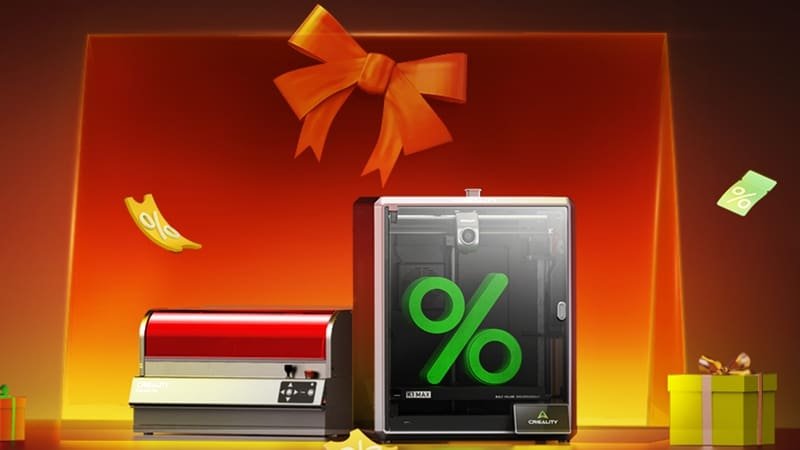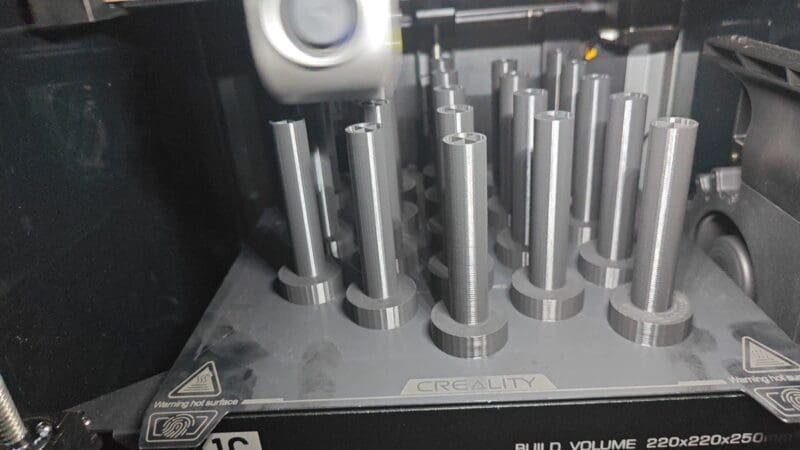How Can 3D Printing be Improved? (10 Quick Facts)
Desktop FDM 3D printers originated in the geek community, and even today, the barrier to entry remains relatively high for newcomers. Beginners often encounter a variety of challenges when using 3D printers, and we frequently receive messages with questions about 3D printing. Therefore, this article presents 10 beginner tips for 3D printing, designed to help you quickly get started with 3D printing.

1. How do I choose the right filament for my 3D printer?
Desktop FDM 3D printing utilizes spooled filament materials, which come in a variety of types based on their characteristics and performance. Common materials include PLA, ABS, ASA, PETG, TPU, PA, and more. The choice of material often depends on the specific application.
PLA (Polylactic Acid) is synthesized from plants such as corn and is biodegradable. It has good strength at room temperature and a low melting point, making it easy to print with.
It emits almost no harmful gases during printing, making it the most popular material for consumer-level users. However, PLA has a low melting point, typically softening at 60-70 degrees Celsius, and is not resistant to aging. It is generally used for indoor items and toys.

Read: Top 8 Best High-Speed PLA Filament 2023
ABS (Acrylonitrile Butadiene Styrene) is a type of engineering plastic with high strength and better temperature resistance, typically up to 90–100 degrees Celsius. It is often used for printing structural parts and product functionality verification.
However, ABS emits harmful gases during printing, so it is generally not recommended for home use.

Read: ASA vs ABS: The Battle of 3D Printing Filaments
ASA is often used as a substitute for ABS, offering similar performance with added corrosion resistance and anti-aging properties. It does not emit harmful gases during printing. ASA is typically used outdoors and in corrosive environments, but it is much more expensive than ABS.
PETG is tough and weather-resistant but has poor heat resistance. The bottles for beverages like cola are made from PET material.
Read: The Best PETG Filament for 3D Printing in 2023
TPU (Thermoplastic Polyurethane) is a flexible material available in different grades, such as 98A, 95A, 90A, 85A, etc. The lower the number, the softer the material, but also the more challenging it is to print.

PA (Polyamide), or nylon, is tough, heat-resistant, and wear-resistant, suitable for printing gears, jigs, and fixtures.
There are also composite materials, such as PA-CF, which is PA with carbon fiber added, and PET-GF, PET with glass fiber added.
If you’re feeling overwhelmed, starting with PLA is a good choice. Remember to choose filaments from well-known manufacturers, as their materials have been extensively tested by many users and come with ready-to-use printing parameters.
Printer manufacturers often prioritize compatibility with their own materials, and using these materials usually just requires selecting the corresponding slicer settings.

2. Adjusting Print Parameters
Material brands typically provide reference printing parameters, including print temperature and speed.
For materials like PLA, ABS, and PETG, using generic slicing parameters usually works fine.
However, pay special attention to the maximum volumetric speed, as differences in materials from various manufacturers can be significant. High-speed printers, without proper flow restrictions based on material parameters, can easily clog.
Material manufacturers will indicate the material’s melt flow index and density.
For example, for ABS, the maximum volumetric speed can be calculated by dividing the melt flow index by the density value and then by 0.6, which approximately equals 12.4. This figure represents the maximum volumetric speed at the recommended temperature for the material.
3. Printing Support tips

Since FDM printing builds objects layer by layer, overhangs or unsupported angles require support structures below them. Modern slicing software, such as Bambu Studio, Ocraslice, and PrusaSlicer, intelligently suggests where supports are needed, and you can easily enable them at the indicated locations.
Beginners should use automatic support generation, but manual mode is available for special requirements. To save on material and avoid deformation due to material shrinkage, FDM 3D printing generally does not print solid objects.
4. Print Infill Tips
Infill is typically hollow to save material. The infill percentage represents the density of the fill inside the printed object, with default settings usually between 12-15%.
For stronger prints, you can increase this to 25% or 40%. The pattern of the infill also varies, with options like grid structures being common choices.
5. Optimizing Model Orientation for 3D Printing
When it comes to 3D printing, the orientation of your model on the build plate is more important than you might think.
For the same model, positioning it one way might require support structures due to overhangs, whereas another orientation might not need any at all.
For example, printing a model vertically might make it prone to breaking easily, but laying it down could significantly reduce this risk. This is because FDM (Fused Deposition Modeling) printers work by laying down material layer by layer.
The bond between these layers is crucial, so for parts that will bear load, orienting them so the Z-axis is parallel to the direction of the force is generally best. This approach can help ensure your prints are as durable as they need to be.
6. Choosing the Right Print Bed Surface
The print bed surface is crucial for the first layer of your print to adhere properly during printing and to release once cooling.
Among the most common options is the PEI (Polyetherimide) sheet, known for its excellent adhesion with various materials when heated and easy release once cooled.
Prints made on PEI sheets often have a textured bottom, which can be aesthetically pleasing for some applications.

However, if you require a smooth bottom surface for your print, perhaps for assembly purposes, a glass bed or a smooth sticker surface might be more appropriate.
The advertising and signage industry, for example, often prefers durable glass beds coated with an adhesive for their prints.

6.1 Prevent warping during printing
Warping during printing is a common issue for beginners. I’ve summarized several scenarios and solutions for your reference:
- If your model has a large bottom surface area with sharp corners, it’s prone to warping. You can enable Brim in your slicing software to prevent this issue.
- Of course, you can also increase the first layer height and reduce the first layer printing speed to improve first layer adhesion. If you’re using an engineering material print bed or a smooth print bed, remember to apply glue before printing.
- Materials like ABS and ASA, which require high temperatures, especially when printing large volume models, can still warp even if the chamber is enclosed, due to insufficient chamber temperature. If your printer has an active chamber heating system, remember to turn it on. If not, you can preheat the heated bed for 30 minutes to an hour before printing to increase the overall chamber temperature, then start printing.
- After using a PEI sheet for a while, you can rinse it with warm water to remove surface grease and dust, improving adhesion. However, do not wipe the PEI sheet with alcohol, as it can cause the coating to peel off. Of course, print beds also have a lifespan. After a long time of printing, if the adhesion decreases, consider replacing the print bed.
7. Preventing Overheating in Enclosed 3D Printers
During the printing process, particularly with materials like PLA which have a lower melting point, it’s important to manage the temperature within enclosed printers.
Ensure the door is open to avoid excessive heat build-up that could soften the filament and cause jams.
Some advanced printers equipped with camera AI can detect issues and send remote alerts.
For those without this feature, consider setting up a network camera to periodically check on your print, especially if you’ll be away for an extended period. This can help avoid material waste or, in the worst cases, damage to the printer head.
8. Monitoring Filament Supply
Before leaving your 3D printer unattended, always check if there’s enough filament. Although most modern printers are equipped with filament runout sensors, a prolonged absence after the filament runs out could lead the printer to turn off the heated bed, causing the model to detach and halt the print.
For users of printers like those from Bambulab that come with an Automatic Material System (AMS), you can enable the auto-feed feature. This allows the printer to automatically switch to a new spool of filament with similar properties once the current one runs out, ensuring continuous printing without manual intervention.
9. Model Adhesion and Removal
PEI sheets are designed to release the model automatically upon cooling, but removing models while the bed is still hot can damage the PEI surface. If a model doesn’t detach by itself after cooling, gently flex the print bed to encourage separation.
Avoid using excessive force to prevent damage. For smooth surfaces, a palette knife can help remove models. When using a brim for better bed adhesion, a palette knife can also assist in cleaning up any residual material that doesn’t come off easily. However, be careful to avoid injury or damage to the bed.
When it comes to removing supports, they should generally come off easily with proper settings. For more stubborn or internal supports, needle-nose pliers can be a useful tool for removal.
Read: PLA Not Sticking to Bed: Best 9 Solutions
10. Storing Filament Correctly
If you’re not planning to print for a while, it’s essential to store your filament properly to prevent degradation. Materials such as ABS, PETG, TPU, and composites like CF and GF are particularly sensitive to moisture and can suffer from issues like stringing, bubbling, or even becoming brittle and breaking if exposed to air for too long.

You can use a commercial dry box or DIY solutions, like a sealed container with desiccant. Manufacturers often ship engineering-grade materials in resealable foil bags — don’t discard these, as they’re ideal for long-term storage. If your printer has an AMS, remember to replace the desiccant as indicated to keep your filament in optimal condition.
Read: Best Filament Dryer in 2024: Top 5 in the Market
DISCLOSURE: THIS POST MAY CONTAIN AFFILIATE LINKS, MEANING I GET A COMMISSION IF you DECIDE TO MAKE A PURCHASE THROUGH MY LINKS, AT NO COST TO YOU. PLEASE READ MY DISCLOSURE FOR MORE INFO.








